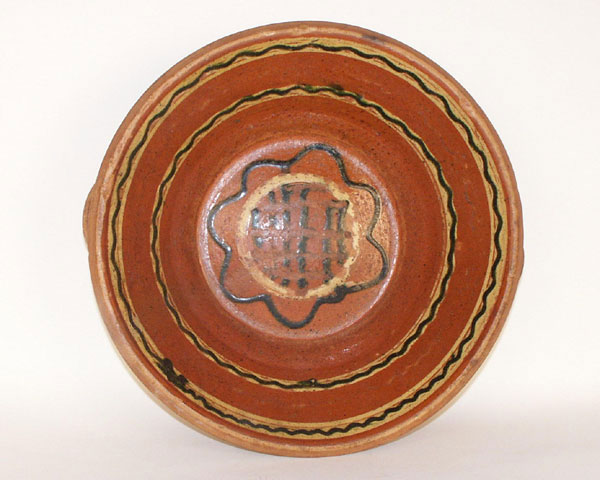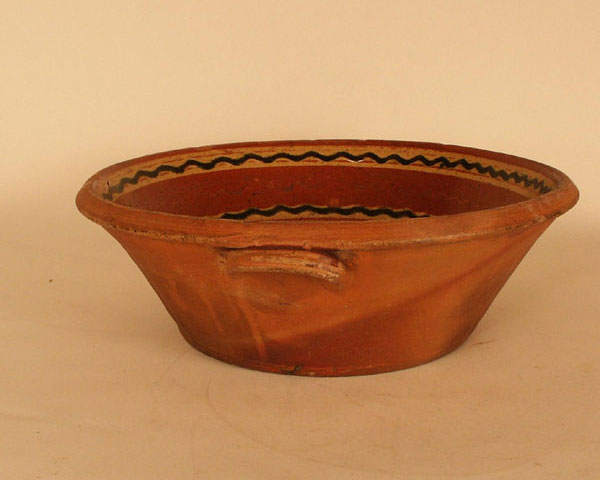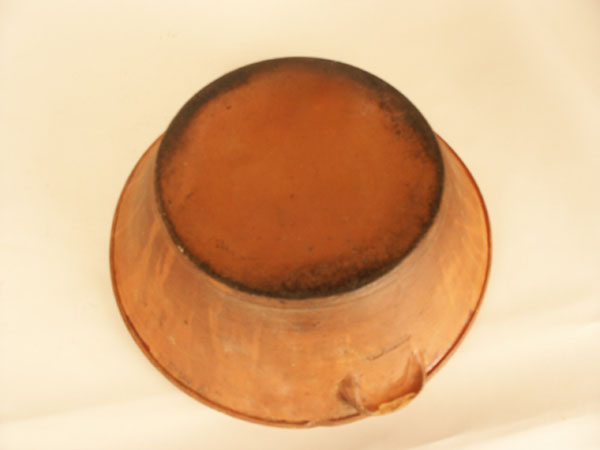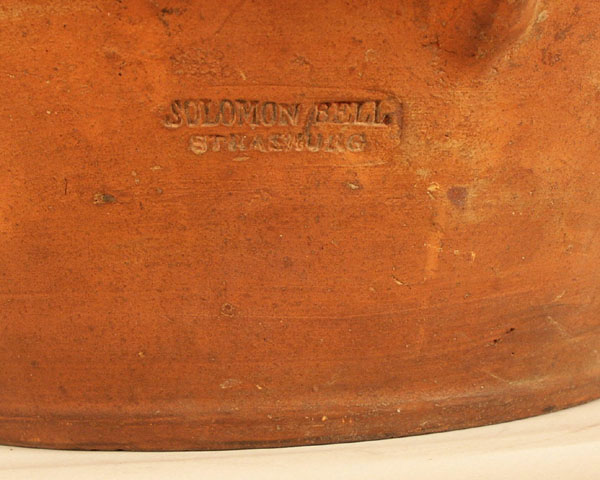

A very rare slip decorated earthenware pan by Solomon Bell
Inside View
Large pans (1) were one of the housewife's requests of historic potters. These utilitarian wares were very important to the early household. Their uses varied from washing the dishes , letting the dough rise, serving the soup or mashed potatoes, depending on the family size, perhaps a punch bowl at family parties, and even as a bath-tub for baby. Many potters added decorations to these items significantly affecting their prices. (2) This of course was the potter's way of advertising his ware and attracting buyers. Most such items were also produced in a plain, one glaze finish.
This brings to mind an early letter, 1857, from Michael Dent Byers to his brother-in-law John Miller a potter in Strasburg. Byers, a brother of Philip Byers, Strasburg potter, had moved to Indiana with most of the potting Miller family in 1838. One of the questions in his letter, "and do they still make the pottery there as beautiful as when I was there?" As time passed, competition eroded work day traditions and production took precedent, leaving only little time for decorations.
The survival rate of such artifacts is extremely poor. Their intended uses, quite often their large size, and the significant utilitarian demands these items withstood, practically dictated destruction. The pan shown here is the only known slip decorated and stamped one, by this potter; others no doubt exist.
Solomon Bell, ( 1817-1882 ) was born in Hagerstown, Maryland. He moved to Winchester, Virginia, with his potter father, Peter, and family in 1824. Significantly influenced by older brothers John and Samuel he became the fourth potter in the early Bell family to propagate the Hagerstown ceramic style up the Shenandoah Valley. Evidence exists that he worked with his brother John, who owned a firm in Waynesboro, Pennsylvania, for some period of time during 1840. Here he learned the molding technique, not practiced in Hagerstown and Winchester. Such technique was abundantly used in his last days in Winchester, and throughout his Strasburg, period. Solomon never took a wife but it appears that he married his trade. Bell died, yet in the trade, March 16,1882. According to Rice (3) he died "from an illness brought on by having overheated himself in drawing a kiln of pottery."
Side View
This pan, 15 inches in width, excluding the handles, by 5 inches high, is not the largest made in the period. Dark green copper oxide slip undulating lines have been applied over white slip banding by the use of brush and slip cup techniques. One undulating line application, between the two primary ones shown, and a portion of the central cross hatching have slaked away over years of weather change and usage. Perhaps the light application of the missing undulant line decoration was an after thought and added after the pan had become too dry. Unfortunately, there is no evidence of what slip color was added here.
The handles were constructed of extruded coils with a simple beaded design. They were applied to the body of the pan in a manner which allowed cradling of the slanting and projecting rim, thus adding support to the finished handle.
Bottom View
The sides of the pan are smooth and the foot is lightly pronounced. The Hagerstown potter's work ethic demanded a smooth, attractive appearance when the external surfaces were finished unglazed. This approach is apparent in other American traditions of the period but none exceed Hagerstown's in consistency. This "neatness" of course, was a German inspiration brought there with the early potters.
Potter's Stamp
The incised mark, "Solomon Bell/Strasburg" as shown in exhibit 4, is a variant of the second Solomon Bell mark (4) in that the "Va" does not appear. It is most probable that either the "Va" did not engage the wet clay or perhaps it fell off the marking device. There are other examples in which the "Va" is not exhibited but insufficient in number to consider it one of the mark styles of Bell.
Reference:
1. Pan. This is period nomenclature for such utilitarian hollow ware items with straight line walls which slant inward, converging, from the lip. This form, with a more rectilinear style, does not answer the definition of a bowl.
2. Peter Bell account book, Pennsylvania Historical Society. July 19, 1843, Mr. Marydeth ( Meredith) to 1 large pan .50. Meredith was perhaps the wealthy Winchester silversmith who would be more able to purchase decorated pottery to please his wife and brighten up the household. Perhaps it was his wife who made the purchase. In the 1843 period a Shenandoah potter working in the master's shop made about .75 per day. In an eight to ten hour day he would have been required to produce from 55-70 large undecorated pans. Most of those produced pans would be left undecorated for quick sales. In July of 1835, Bell sold a large pan for .14, obviously not decorated.
3. The Shenandoah Pottery, A. H. Rice and John Baer Stoudt, Shenandoah Publishing House, Inc., Strasburg, Virginia, 1929, p.57
4. The Pottery of the Shenandoah Valley Region, H. E. Comstock, The Museum of Early Southern Decorative Arts, Winston-Salem NC, 1954, pp. 210-211.












